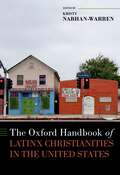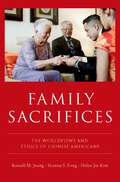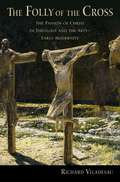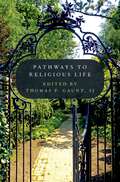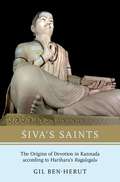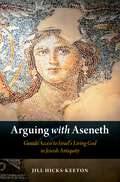- Table View
- List View
Helena Augusta: Mother of the Empire (WOMEN IN ANTIQUITY)
by Julia HillnerIn the middle of the third century, a girl was born on the north-eastern frontier of the Roman empire. Eighty years later, she died as Flavia Iulia Helena, Augusta of the Roman world and mother of the first Christian emperor Constantine, without ever having been married to an emperor herself. In Helena Augusta: Mother of the Empire, Julia Hillner traces Helena's story through her life's peaks, which generated beautiful imperial artwork, entertaining legends as well as literary outrage. But Helena Augusta also pays careful attention to the disruptions in Helena's life course and in her commemoration--disruptions that were created by her nearest male relatives. Hillner shows that Helena's story was not just determined by the love of a son or the rise of Christianity. It was also--like that of many other late Roman women--defined by male violence and by the web of changing female relationships around her, to which Helena was sometimes marginal, sometimes central and sometimes ancillary. Helena Augusta offers unique insight into the roles of imperial women in Constantinian self-display and in dynastic politics from the Tetrarchy to the Theodosian Age, and it also reminds us that the late Roman female life course, even that of an empress, was fragile and non-linear.
Helena Augusta: Mother of the Empire (WOMEN IN ANTIQUITY)
by Julia HillnerIn the middle of the third century, a girl was born on the north-eastern frontier of the Roman empire. Eighty years later, she died as Flavia Iulia Helena, Augusta of the Roman world and mother of the first Christian emperor Constantine, without ever having been married to an emperor herself. In Helena Augusta: Mother of the Empire, Julia Hillner traces Helena's story through her life's peaks, which generated beautiful imperial artwork, entertaining legends as well as literary outrage. But Helena Augusta also pays careful attention to the disruptions in Helena's life course and in her commemoration--disruptions that were created by her nearest male relatives. Hillner shows that Helena's story was not just determined by the love of a son or the rise of Christianity. It was also--like that of many other late Roman women--defined by male violence and by the web of changing female relationships around her, to which Helena was sometimes marginal, sometimes central and sometimes ancillary. Helena Augusta offers unique insight into the roles of imperial women in Constantinian self-display and in dynastic politics from the Tetrarchy to the Theodosian Age, and it also reminds us that the late Roman female life course, even that of an empress, was fragile and non-linear.
Experimenting with Religion: The New Science of Belief
by Jonathan JongAcross history, our understanding of God, the soul, spirituality, and even science itself has shifted dramatically. Today, we have more scientific knowledge than ever, yet some age-old questions persist: Why do we believe in gods, souls, and rituals? Are these beliefs innate? Do existential fears drive us toward or away from religion? What can we learn about spirituality from children? How can we leverage scientific thinking to study spirituality? This book invites you into the labs and minds of some of the world's most renowned psychological scientists for an in-depth look at how psychologists can study religion and spirituality-and how they wrestle with doubts about ostensibly established findings and methods, even as the field advances. From China, India, Brazil, the United Kingdom, the United States, and Tuva, this book takes a balanced perspective on a diverse range of experiments and studies, casting a light on both their brilliance and their limitations. Ultimately, this book reveals that psychological experiments that test spiritual beliefs are works of imagination that can help us discover truths about the human mind's proclivity for religious ideas, as long as we can adapt and learn along the way.
Experimenting with Religion: The New Science of Belief
by Jonathan JongAcross history, our understanding of God, the soul, spirituality, and even science itself has shifted dramatically. Today, we have more scientific knowledge than ever, yet some age-old questions persist: Why do we believe in gods, souls, and rituals? Are these beliefs innate? Do existential fears drive us toward or away from religion? What can we learn about spirituality from children? How can we leverage scientific thinking to study spirituality? This book invites you into the labs and minds of some of the world's most renowned psychological scientists for an in-depth look at how psychologists can study religion and spirituality-and how they wrestle with doubts about ostensibly established findings and methods, even as the field advances. From China, India, Brazil, the United Kingdom, the United States, and Tuva, this book takes a balanced perspective on a diverse range of experiments and studies, casting a light on both their brilliance and their limitations. Ultimately, this book reveals that psychological experiments that test spiritual beliefs are works of imagination that can help us discover truths about the human mind's proclivity for religious ideas, as long as we can adapt and learn along the way.
The Oxford Handbook of Latinx Christianities in the United States (Oxford Handbooks)
The United States is in the midst of a demographic revolution. It is estimated that by 2050 Latinx Americans will make up thirty percent of the nation's total population. Most Latinx Americans today are Christian. And while, historically, most of those Latinx Christians have been Catholics, that is changing as well, as more Latinx Americans embrace Protestantism or other traditions and practices. Even within the U.S. Catholic Church the demographic changes are being felt, as more than half of young American Catholics are Latinx. The Oxford Handbook of Latinx Christianities in the United States provides an introduction to U.S. Latinx Christianities, helping readers better understand the largest minority group in the United States. The chapters are written by specialists in U.S. Latinx Christianities from fields such as history, theology, and sociology and organized by theme. The essays, taken individually and collectively, pay attention to both historical and contemporary aspects of major Christian denominations and movements. This handbook provides in-depth coverage of specific national groups, denominations, geographies, and theologies, and also attends to themes of gender, sexuality, empire, migration, diaspora, borderlands, and transnationalism. This volume is a go-to source for anyone interested in the role that religion, specifically Christianity, plays in the lives of U.S. Latinxs.
The Oxford Handbook of Latinx Christianities in the United States (Oxford Handbooks)
by Kristy Nabhan-WarrenThe United States is in the midst of a demographic revolution. It is estimated that by 2050 Latinx Americans will make up thirty percent of the nation's total population. Most Latinx Americans today are Christian. And while, historically, most of those Latinx Christians have been Catholics, that is changing as well, as more Latinx Americans embrace Protestantism or other traditions and practices. Even within the U.S. Catholic Church the demographic changes are being felt, as more than half of young American Catholics are Latinx. The Oxford Handbook of Latinx Christianities in the United States provides an introduction to U.S. Latinx Christianities, helping readers better understand the largest minority group in the United States. The chapters are written by specialists in U.S. Latinx Christianities from fields such as history, theology, and sociology and organized by theme. The essays, taken individually and collectively, pay attention to both historical and contemporary aspects of major Christian denominations and movements. This handbook provides in-depth coverage of specific national groups, denominations, geographies, and theologies, and also attends to themes of gender, sexuality, empire, migration, diaspora, borderlands, and transnationalism. This volume is a go-to source for anyone interested in the role that religion, specifically Christianity, plays in the lives of U.S. Latinxs.
Family Sacrifices: The Worldviews and Ethics of Chinese Americans
by Russell M. Jeung Seanan S. Fong Helen Jin KimFifty-two percent of Chinese Americans report having no religious affiliation, making them the least religiously-identified ethnic group in the United States. But that statistic obscures a much more complex reality. Family Sacrifices reveals that Chinese Americans employ familism, not religion, as the primary narrative by which they find meaning, identity, and belonging. As a transpacific lived tradition, Chinese American familism prioritizes family above other commitments and has roots in Chinese Popular Religion and Confucianism. The spiritual and ethical systems of China emphasize practicing rituals and cultivating virtue, whereas American religious research usually focuses on belief in the supernatural or belonging to a religious tradition. To address this gap in understanding, Family Sacrifices introduces the concept of liyi, translated as ritual propriety and righteous relations. Re-appropriated from its original Chinese usage, liyi offers a new way of understanding Chinese religion and a new lens for understanding the emergence of religious "nones" in the United States. The first book based on national survey data on Asian American religious practices, Family Sacrifices is a seminal text on the fastest-growing racial group in the United States.
Family Sacrifices: The Worldviews and Ethics of Chinese Americans
by Russell M. Jeung Seanan S. Fong Helen Jin KimFifty-two percent of Chinese Americans report having no religious affiliation, making them the least religiously-identified ethnic group in the United States. But that statistic obscures a much more complex reality. Family Sacrifices reveals that Chinese Americans employ familism, not religion, as the primary narrative by which they find meaning, identity, and belonging. As a transpacific lived tradition, Chinese American familism prioritizes family above other commitments and has roots in Chinese Popular Religion and Confucianism. The spiritual and ethical systems of China emphasize practicing rituals and cultivating virtue, whereas American religious research usually focuses on belief in the supernatural or belonging to a religious tradition. To address this gap in understanding, Family Sacrifices introduces the concept of liyi, translated as ritual propriety and righteous relations. Re-appropriated from its original Chinese usage, liyi offers a new way of understanding Chinese religion and a new lens for understanding the emergence of religious "nones" in the United States. The first book based on national survey data on Asian American religious practices, Family Sacrifices is a seminal text on the fastest-growing racial group in the United States.
Millennial Missionaries: How a Group of Young Catholics is Trying to Make Catholicism Cool
by Katherine DuganMillennials in the U.S. have been characterized as uninterested in religion, as defectors from religious institutions, and as agnostic about the role of religious identity in their culture. Amid the rise of so-called "nones," though, there has also been a countervailing trend: an increase in religious piety among some millennial Catholics. The Fellowship of Catholic University Students (FOCUS), which began evangelizing college students on American university campuses in 1998, hires recent college graduates to evangelize college students and promote an attractive and culturally savvy Catholicism. These millennial Catholics have personal relationships with Jesus, attend Mass daily, and know and defend papal teachings, while also being immersed in U.S. popular culture. With their skinny jeans, devotional tattoos, and large-framed glasses, FOCUS missionaries embody a hip, attractive style of Catholicism. They promote a faith that interweaves distinctly Catholic identity with outreach methods of twentieth-century evangelical Protestants and the anxieties of middle-class emerging adulthood. Though this new generation of missionaries lives according to strict gender essentialism prescribed by papal teachings-including the notions that men lead while women follow and that biology dictates gender roles-they also support stay-at-home fatherhood and women earning MBAs. Millennial Missionaries examines how these young people navigate their Catholic and American identities in the twenty-first century. Illuminating the ways missionaries are reshaping American Catholic identity, Katherine Dugan explores the contemporary U.S. religious landscape from the perspective of millennials who proudly proclaim "I am Catholic"-and devote years of their lives to convincing others to do the same.
Millennial Missionaries: How a Group of Young Catholics is Trying to Make Catholicism Cool
by Katherine DuganMillennials in the U.S. have been characterized as uninterested in religion, as defectors from religious institutions, and as agnostic about the role of religious identity in their culture. Amid the rise of so-called "nones," though, there has also been a countervailing trend: an increase in religious piety among some millennial Catholics. The Fellowship of Catholic University Students (FOCUS), which began evangelizing college students on American university campuses in 1998, hires recent college graduates to evangelize college students and promote an attractive and culturally savvy Catholicism. These millennial Catholics have personal relationships with Jesus, attend Mass daily, and know and defend papal teachings, while also being immersed in U.S. popular culture. With their skinny jeans, devotional tattoos, and large-framed glasses, FOCUS missionaries embody a hip, attractive style of Catholicism. They promote a faith that interweaves distinctly Catholic identity with outreach methods of twentieth-century evangelical Protestants and the anxieties of middle-class emerging adulthood. Though this new generation of missionaries lives according to strict gender essentialism prescribed by papal teachings-including the notions that men lead while women follow and that biology dictates gender roles-they also support stay-at-home fatherhood and women earning MBAs. Millennial Missionaries examines how these young people navigate their Catholic and American identities in the twenty-first century. Illuminating the ways missionaries are reshaping American Catholic identity, Katherine Dugan explores the contemporary U.S. religious landscape from the perspective of millennials who proudly proclaim "I am Catholic"-and devote years of their lives to convincing others to do the same.
The Folly of the Cross: The Passion of Christ in Theology and the Arts in Early Modernity
by Richard ViladesauThe Folly of the Cross is the fourth book in Richard Viladesau's series examining the aesthetics and theology of the cross through Christian history. Previous volumes have brought the story up through the Baroque era. This new book examines the reception of the message of the cross from the European Enlightenment to the turn of the twentieth century. The opening chapters set the stage in the transition from the Baroque to the Classical eras, describing the changing intellectual and cultural paradigms of the time. Viladesau examines the theology of the cross in the eighteenth and nineteenth centuries, and the aesthetic mediation of the cross in music and the visual arts. He shows how in the post-Enlightenment era the aesthetic treatment of the cross widely replaced the dogmatic treatment, and how this thought was translated into popular spirituality, piety, and devotion. The Folly of the Cross shows how classical theology responded to the critiques of modern science, history, Biblical scholarship, and philosophy, and how both classical and modern theology served as the occasions for new forms of representation of Christ's passion in the arts and music.
FOLLY OF THE CROSS C: The Passion of Christ in Theology and the Arts in Early Modernity
by Richard ViladesauThe Folly of the Cross is the fourth book in Richard Viladesau's series examining the aesthetics and theology of the cross through Christian history. Previous volumes have brought the story up through the Baroque era. This new book examines the reception of the message of the cross from the European Enlightenment to the turn of the twentieth century. The opening chapters set the stage in the transition from the Baroque to the Classical eras, describing the changing intellectual and cultural paradigms of the time. Viladesau examines the theology of the cross in the eighteenth and nineteenth centuries, and the aesthetic mediation of the cross in music and the visual arts. He shows how in the post-Enlightenment era the aesthetic treatment of the cross widely replaced the dogmatic treatment, and how this thought was translated into popular spirituality, piety, and devotion. The Folly of the Cross shows how classical theology responded to the critiques of modern science, history, Biblical scholarship, and philosophy, and how both classical and modern theology served as the occasions for new forms of representation of Christ's passion in the arts and music.
Pathways to Religious Life
The history of religious life in the Catholic Church has been filled with change: periods of membership growth and decline, shifts in the types of ministries, and changes in the ethnic and socioeconomic backgrounds of the men and women who join. Today, as the numbers of new members diminish, some say that the very future of religious life is in jeopardy. What is the state of religious life in the United States today? Which institutes are increasing in membership and which are decreasing or ceasing to exist? From what ethnic and socioeconomic populations are they drawing their members? What new religious institutes and ecclesial movements are being founded and how successful are they? What influences a young man or woman to consider religious life today? How are religious from other countries shaping religious life here as they come to the US to minister? Many of these questions can be addressed by data from studies of religious life in the US which the Center for Applied Research in the Apostolate (CARA) has conducted over the last ten years. The impact of the individual's family dynamics and educational experience before their entrance into religious life is examined here, as well as the influence of an increasing number of Catholic volunteer programs. The emergence of lay associates in religious institutes and the birth of new religious institutes since Vatican Council II in the United States are investigated as new ways of living religious life. The increase in the number of sisters and priests studying and ministering in the United States from other countries is examined for its impact on religious life. The authors' findings yield valuable recommendations for religious institutes and vocation directors who wish to attract new members.
Pathways to Religious Life
by Thomas P. Gaunt, SJThe history of religious life in the Catholic Church has been filled with change: periods of membership growth and decline, shifts in the types of ministries, and changes in the ethnic and socioeconomic backgrounds of the men and women who join. Today, as the numbers of new members diminish, some say that the very future of religious life is in jeopardy. What is the state of religious life in the United States today? Which institutes are increasing in membership and which are decreasing or ceasing to exist? From what ethnic and socioeconomic populations are they drawing their members? What new religious institutes and ecclesial movements are being founded and how successful are they? What influences a young man or woman to consider religious life today? How are religious from other countries shaping religious life here as they come to the US to minister? Many of these questions can be addressed by data from studies of religious life in the US which the Center for Applied Research in the Apostolate (CARA) has conducted over the last ten years. The impact of the individual's family dynamics and educational experience before their entrance into religious life is examined here, as well as the influence of an increasing number of Catholic volunteer programs. The emergence of lay associates in religious institutes and the birth of new religious institutes since Vatican Council II in the United States are investigated as new ways of living religious life. The increase in the number of sisters and priests studying and ministering in the United States from other countries is examined for its impact on religious life. The authors' findings yield valuable recommendations for religious institutes and vocation directors who wish to attract new members.
Freud's Mahabharata
by Alf HiltebeitelThough Freud never overtly refers to the Mahthe companion volume to Freud's India, Alf Hiltebeitel offers what he calls a "pointillist introduction" to a new theory about the Mah
Freud's Mahabharata
by Alf HiltebeitelThough Freud never overtly refers to the Mahthe companion volume to Freud's India, Alf Hiltebeitel offers what he calls a "pointillist introduction" to a new theory about the Mah
Freud's India: Sigmund Freud and India's First Psychoanalyst Girindrasekhar Bose
by Alf HiltebeitelThe sharp contrast between cultures with a monotheistic paternal deity and those with pluralistic maternal deities is a theme of abiding interest in religious studies. Attempts to understand the implications of these two vast organizing principles for religious life lead to an overwhelmingly diverse set of facts and their meanings. In Freud's India, the companion volume to Freud's Mahs-- Sigmund Freud and Girindrasekhar Bose. Hiltebeitel examines the attempts of these two men to communicate with and understand each other and these issues in the heated context of emotionally divisive allegiances. The book is elegant in its nuanced attention to these two thinkers and its tightly controlled exploration of what their interactions reveal about their contributions and limitations as representatives of the psychology and religion of their respective cultures. Anxieties about mothers, says Hiltebeitel, separate Eastern from Western imaginations. They separate Freud from Bose, and they separate Hindu foundational texts from the foundational texts of Judaism.
Freud's India: Sigmund Freud and India's First Psychoanalyst Girindrasekhar Bose
by Alf HiltebeitelThe sharp contrast between cultures with a monotheistic paternal deity and those with pluralistic maternal deities is a theme of abiding interest in religious studies. Attempts to understand the implications of these two vast organizing principles for religious life lead to an overwhelmingly diverse set of facts and their meanings. In Freud's India, the companion volume to Freud's Mahs-- Sigmund Freud and Girindrasekhar Bose. Hiltebeitel examines the attempts of these two men to communicate with and understand each other and these issues in the heated context of emotionally divisive allegiances. The book is elegant in its nuanced attention to these two thinkers and its tightly controlled exploration of what their interactions reveal about their contributions and limitations as representatives of the psychology and religion of their respective cultures. Anxieties about mothers, says Hiltebeitel, separate Eastern from Western imaginations. They separate Freud from Bose, and they separate Hindu foundational texts from the foundational texts of Judaism.
The Buddhist Roots of Zhu Xi's Philosophical Thought
Zhu Xi (1130-1200) is the most influential Neo-Confucian philosopher and arguably the most important Chinese philosopher of the past millennium, both in terms of his legacy and for the sophistication of his systematic philosophy. The Buddhist Roots of Zhu Xi's Philosophical Thought combines in a single study two major areas of Chinese philosophy that are rarely tackled together: Chinese Buddhist philosophy and Zhu Xi's Neo-Confucian philosophy. Despite Zhu Xi's importance as a philosopher, the role of Buddhist thought and philosophy in the construction of his systematic philosophy remains poorly understood. What aspects of Buddhism did he criticize and why? Was his engagement limited to criticism (informed or otherwise) or did Zhu also appropriate and repurpose Buddhist ideas to develop his own thought? If Zhu's philosophical repertoire incorporated conceptual structures and problematics that are marked by a distinct Buddhist pedigree, what implications does this have for our understanding of his philosophical project? The five chapters that make up The Buddhist Roots of Zhu Xi's Philosophical Thought present a rich and complex portrait of the Buddhist roots of Zhu Xi's philosophical thought. The scholarship is meticulous, the analysis is rigorous, and the philosophical insights are fresh. Collectively, the chapters illuminate a greatly expanded range of the intellectual resources Zhu incorporated into his philosophical thought, demonstrating the vital role that models derived from Buddhism played in his philosophical repertoire. In doing so, they provide new perspectives on what Zhu Xi was trying to achieve as a philosopher, by repurposing ideas from Buddhism. They also make significant and original contributions to our understanding of core concepts, debates and conceptual structures that shaped the development of philosophy in East Asia over the past millennium.
The Buddhist Roots of Zhu Xi's Philosophical Thought
by John MakehamZhu Xi (1130-1200) is the most influential Neo-Confucian philosopher and arguably the most important Chinese philosopher of the past millennium, both in terms of his legacy and for the sophistication of his systematic philosophy. The Buddhist Roots of Zhu Xi's Philosophical Thought combines in a single study two major areas of Chinese philosophy that are rarely tackled together: Chinese Buddhist philosophy and Zhu Xi's Neo-Confucian philosophy. Despite Zhu Xi's importance as a philosopher, the role of Buddhist thought and philosophy in the construction of his systematic philosophy remains poorly understood. What aspects of Buddhism did he criticize and why? Was his engagement limited to criticism (informed or otherwise) or did Zhu also appropriate and repurpose Buddhist ideas to develop his own thought? If Zhu's philosophical repertoire incorporated conceptual structures and problematics that are marked by a distinct Buddhist pedigree, what implications does this have for our understanding of his philosophical project? The five chapters that make up The Buddhist Roots of Zhu Xi's Philosophical Thought present a rich and complex portrait of the Buddhist roots of Zhu Xi's philosophical thought. The scholarship is meticulous, the analysis is rigorous, and the philosophical insights are fresh. Collectively, the chapters illuminate a greatly expanded range of the intellectual resources Zhu incorporated into his philosophical thought, demonstrating the vital role that models derived from Buddhism played in his philosophical repertoire. In doing so, they provide new perspectives on what Zhu Xi was trying to achieve as a philosopher, by repurposing ideas from Buddhism. They also make significant and original contributions to our understanding of core concepts, debates and conceptual structures that shaped the development of philosophy in East Asia over the past millennium.
Siva's Saints: The Origins of Devotion in Kannada according to Harihara's Ragalegalu
by Gil Ben-HerutComprising more than twelve million people and renowned for their resistance to Brahminical values, the Virasaivas are a vibrant and unorthodox religious community with a provocative socio-political voice. The Virasaiva tradition has produced a vast and original body of literature, composed mostly in Kannada, a Dravidian language from south India. Siva's Saints introduces a previously unexplored and central primary work produced in the early thirteenth century, the Ragalegalu. This was the first narrative text written about the incipient devotional tradition dedicated to the god Siva in the Kannada-speaking regions; through stories of the saints, it images the life of this new religious community. The Ragalegalu inaugurated a new era in the production of devotional narratives accessible to wide audiences. Gil Ben-Herut challenges common notions about this tradition in its nascent phases. By closely reading the saints' stories in this text, Siva's Saints takes a more nuanced historical view than commonly-held notions about the egalitarian and iconoclastic nature of the early tradition, arguing instead that early bhakti (devotionalism) in the Kannada-speaking region was less-radical and more accommodating toward traditional religious, social, and political institutions than thought of today. In contrast to the narrowly sectarian and exclusionary vision that shapes later accounts, the Ragalegalu is characterized by an opposite impulse of offering an open invitation to people from all walks of life, and their stories illustrate the richness of their devotional lives. Analysis of this seminal text yields important insights into the role of literary representation of the social and political development of a religious community in a pre-modern and non-Western milieu.
Siva's Saints: The Origins of Devotion in Kannada according to Harihara's Ragalegalu
by Gil Ben-HerutComprising more than twelve million people and renowned for their resistance to Brahminical values, the Virasaivas are a vibrant and unorthodox religious community with a provocative socio-political voice. The Virasaiva tradition has produced a vast and original body of literature, composed mostly in Kannada, a Dravidian language from south India. Siva's Saints introduces a previously unexplored and central primary work produced in the early thirteenth century, the Ragalegalu. This was the first narrative text written about the incipient devotional tradition dedicated to the god Siva in the Kannada-speaking regions; through stories of the saints, it images the life of this new religious community. The Ragalegalu inaugurated a new era in the production of devotional narratives accessible to wide audiences. Gil Ben-Herut challenges common notions about this tradition in its nascent phases. By closely reading the saints' stories in this text, Siva's Saints takes a more nuanced historical view than commonly-held notions about the egalitarian and iconoclastic nature of the early tradition, arguing instead that early bhakti (devotionalism) in the Kannada-speaking region was less-radical and more accommodating toward traditional religious, social, and political institutions than thought of today. In contrast to the narrowly sectarian and exclusionary vision that shapes later accounts, the Ragalegalu is characterized by an opposite impulse of offering an open invitation to people from all walks of life, and their stories illustrate the richness of their devotional lives. Analysis of this seminal text yields important insights into the role of literary representation of the social and political development of a religious community in a pre-modern and non-Western milieu.
Arguing with Aseneth: Gentile Access to Israel's Living God in Jewish Antiquity
by Jill Hicks-KeetonArguing with Aseneth shows how the ancient Jewish romance known as Joseph and Aseneth moves a minor character in Genesis from obscurity to renown, weaving a new story whose main purpose was to intervene in ancient Jewish debates surrounding gentile access to Israel's God. Written in Greco-Roman Egypt around the turn of the era, Joseph and Aseneth combines the genre of the ancient Greek novel with scriptural characters from the story of Joseph as it retells Israel's mythic past to negotiate communal boundaries in its own present. With attention to the ways in which Aseneth's tale "remixes" Genesis, wrestles with Deuteronomic theology, and adopts prophetic visions of the future, Arguing with Aseneth demonstrates that this ancient novel inscribes into Israel's sacred narrative a precedent for gentile inclusion in the people belonging to Israel's God. Aseneth is transformed from material mother of the sons of Joseph to a mediator of God's mercy and life to future penitents, Jew and gentile alike. Yet not all Jewish thinkers in antiquity drew boundary lines the same way or in the same place. Arguing with Aseneth traces, then, not only the way in which Joseph and Aseneth affirms the possibility of gentile incorporation but also ways in which other ancient Jewish thinkers, including the apostle Paul, would have argued back, contesting Joseph and Aseneth's very conclusions or offering alternative, competing strategies of inclusion. With its use of a female protagonist, Joseph and Aseneth offers a distinctive model of gentile incorporation--one that eschews lines of patrilineal descent and undermines ethnicity and genealogy as necessary markers of belonging. Such a reading of this narrative shows us that we need to rethink our accounts of how ancient Jewish thinkers, including our earliest example from the Jesus Movement, negotiated who was in and who was out when it came to the people of Israel's God.
Arguing with Aseneth: Gentile Access to Israel's Living God in Jewish Antiquity
by Jill Hicks-KeetonArguing with Aseneth shows how the ancient Jewish romance known as Joseph and Aseneth moves a minor character in Genesis from obscurity to renown, weaving a new story whose main purpose was to intervene in ancient Jewish debates surrounding gentile access to Israel's God. Written in Greco-Roman Egypt around the turn of the era, Joseph and Aseneth combines the genre of the ancient Greek novel with scriptural characters from the story of Joseph as it retells Israel's mythic past to negotiate communal boundaries in its own present. With attention to the ways in which Aseneth's tale "remixes" Genesis, wrestles with Deuteronomic theology, and adopts prophetic visions of the future, Arguing with Aseneth demonstrates that this ancient novel inscribes into Israel's sacred narrative a precedent for gentile inclusion in the people belonging to Israel's God. Aseneth is transformed from material mother of the sons of Joseph to a mediator of God's mercy and life to future penitents, Jew and gentile alike. Yet not all Jewish thinkers in antiquity drew boundary lines the same way or in the same place. Arguing with Aseneth traces, then, not only the way in which Joseph and Aseneth affirms the possibility of gentile incorporation but also ways in which other ancient Jewish thinkers, including the apostle Paul, would have argued back, contesting Joseph and Aseneth's very conclusions or offering alternative, competing strategies of inclusion. With its use of a female protagonist, Joseph and Aseneth offers a distinctive model of gentile incorporation--one that eschews lines of patrilineal descent and undermines ethnicity and genealogy as necessary markers of belonging. Such a reading of this narrative shows us that we need to rethink our accounts of how ancient Jewish thinkers, including our earliest example from the Jesus Movement, negotiated who was in and who was out when it came to the people of Israel's God.
The Bundahi%sn: The Zoroastrian Book of Creation
by Domenico Agostini Samuel Thrope Shaul Shaked Guy StroumsaThe Bundahisn, meaning primal or foundational creation, is the central Zoroastrian account of creation, cosmology, and eschatology. Compiled sometime in the ninth century CE, it is one of the most important surviving testaments to Zoroastrian literature in the Middle Persian language and to pre-Islamic Iranian culture. Despite having been composed some two millennia after the Prophet Zoroaster's revelation, it is nonetheless a concise compendium of ancient Zoroastrian knowledge that draws on and reshapes earlier layers of the tradition. Well known in the field of Iranian Studies as an essential primary source for scholars of ancient Iran's history, religions, literatures, and languages, the Bundahisn is also a great work of literature in and of itself, ranking alongside the creation myths of other ancient traditions. The book's thirty-six diverse chapters, which touch on astronomy, eschatology, zoology, medicine, and more, are composed in a variety of styles, registers, and genres, from spare lists and concise commentaries to philosophical discourses and poetic eschatological visions. This new translation, the first in English in nearly a century, highlights the aesthetic quality, literary style, and complexity and raises the profile of pre-Islamic Zoroastrian literature.


